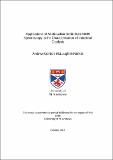Files in this item
Applications of multinuclear solid-state NMR spectroscopy to the characterisation of industrial catalysts
Item metadata
| dc.contributor.advisor | Ashbrook, Sharon E. | |
| dc.contributor.author | Rankin, Andrew Gordon McLaughlin | |
| dc.coverage.spatial | xv, 255 p. | en_US |
| dc.date.accessioned | 2018-02-27T09:52:47Z | |
| dc.date.available | 2018-02-27T09:52:47Z | |
| dc.date.issued | 2018-06-27 | |
| dc.identifier.uri | https://hdl.handle.net/10023/12793 | |
| dc.description.abstract | This thesis describes applications of advanced multinuclear solid-state nuclear magnetic resonance (NMR) experiments to the characterisation of industrially-relevant catalyst materials. Experiments on γ-Al₂O₃ introduce the use of solid-state NMR spectroscopy for the investigation of disordered solids. The existence of Al(V) sites on the surface of this material is demonstrated, showing that removal of adsorbed H₂O may facilitate a rearrangement effect in γ-Al₂O₃ that promotes the formation of these Al environments. A range of aluminium oxide-based supported metal catalysts has been investigated. Studies of these systems by ¹H and ²⁷Al solid-state NMR spectroscopy indicate that a metal-support interaction (MSI) exists between surface cobalt oxide crystallites and the γ-Al₂O₃ support, and is strongest for materials containing small, well dispersed Co oxide crystallites. It is shown that the hygroscopic nature of γ-Al₂O₃ allows the extent of the MSI to be visualised by ¹H MAS NMR, by observing the extent of the proton-metal oxide interaction resulting from the presence of adventitious adsorbed H₂O. The surface/bulk chemistry of Co spinel aluminate materials is also investigated. ¹H, ²⁹Si, ²⁷Al and ¹⁷O solid-state NMR techniques are used to gain insight into the structural nature of silicated alumina catalysts. The combination of isotopic enrichment and dynamic nuclear polarisation (DNP) surface-enhanced NMR spectroscopy can provide a definitive and fully quantitative description of the surface structure of Si-γ-Al₂O₃ (1.5 wt% Si), and the role of adventitious surface water is highlighted. Analysis of silicated aluminas prepared by “sequential grafting” and “single shot” approaches shows that silica growth on γ-Al₂O₃ follows two distinct morphologies. ¹⁷O gas exchange enrichment is also shown to be successful in facilitating ¹⁷O solid-state NMR studies of these materials. It is demonstrated that double (²⁹Si and ¹⁷O) enrichment of Si-γ-Al₂O₃ (1.5 wt% Si) can facilitate access to ²⁹Si-¹⁷O 2D correlation experiments, even at low silica loading. An exploratory investigation of Ti-alumina model catalysts has also been carried out using ¹H, ²⁷Al and ¹⁷O solid-state NMR spectroscopy. These studies indicate that Ti-γ-Al₂O₃ and Ti-Al M50 may be structurally distinct materials. | |
| dc.language.iso | en | en_US |
| dc.publisher | University of St Andrews | |
| dc.subject | Spectroscopy | en |
| dc.subject | Catalysts | en |
| dc.subject | Industrial | en |
| dc.subject | Isotopic enrichment | en |
| dc.subject | DNP | en |
| dc.subject | Gamma-alumina | en |
| dc.subject | Paramagnetic | en |
| dc.subject | Cobalt oxide | en |
| dc.subject | Silicated alumina | en |
| dc.subject | Silica | en |
| dc.subject | Solid-state NMR | en |
| dc.subject | Metal-support interaction | en |
| dc.subject | Ti-alumina | en |
| dc.subject | Adventitious water | en |
| dc.subject.lcc | QD96.N8R2 | |
| dc.subject.lcsh | Nuclear magnetic resonance spectroscopy | en |
| dc.subject.lcsh | Catalysts--Analysis | en |
| dc.title | Applications of multinuclear solid-state NMR spectroscopy to the characterisation of industrial catalysts | en_US |
| dc.type | Thesis | en_US |
| dc.contributor.sponsor | Engineering and Physical Sciences Research Council (EPSRC) | en_US |
| dc.contributor.sponsor | Sasol Technology UK | en_US |
| dc.type.qualificationlevel | Doctoral | en_US |
| dc.type.qualificationname | PhD Doctor of Philosophy | en_US |
| dc.publisher.institution | The University of St Andrews | en_US |
| dc.identifier.doi | https://doi.org/10.17630/10023-12793 |
This item appears in the following Collection(s)
Items in the St Andrews Research Repository are protected by copyright, with all rights reserved, unless otherwise indicated.

